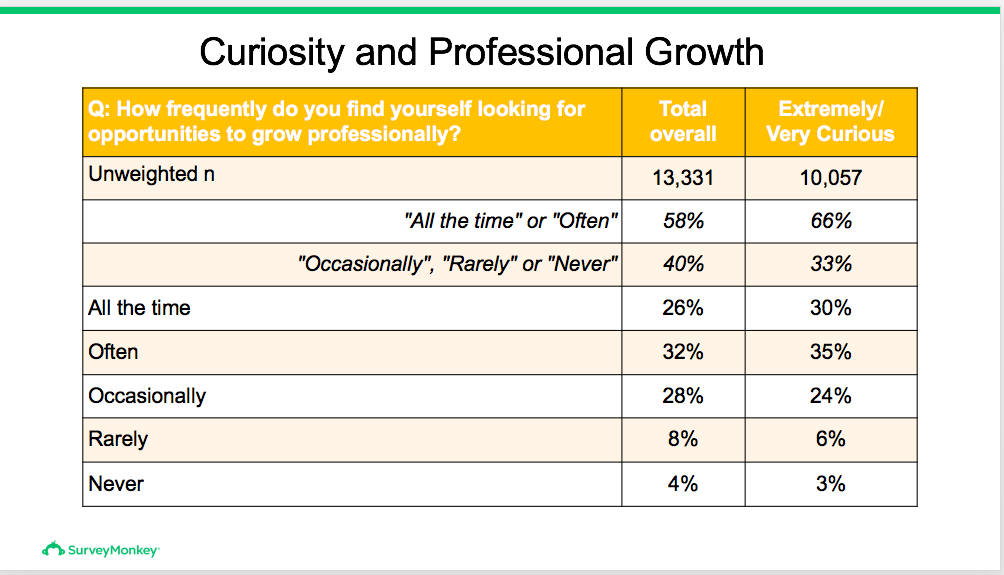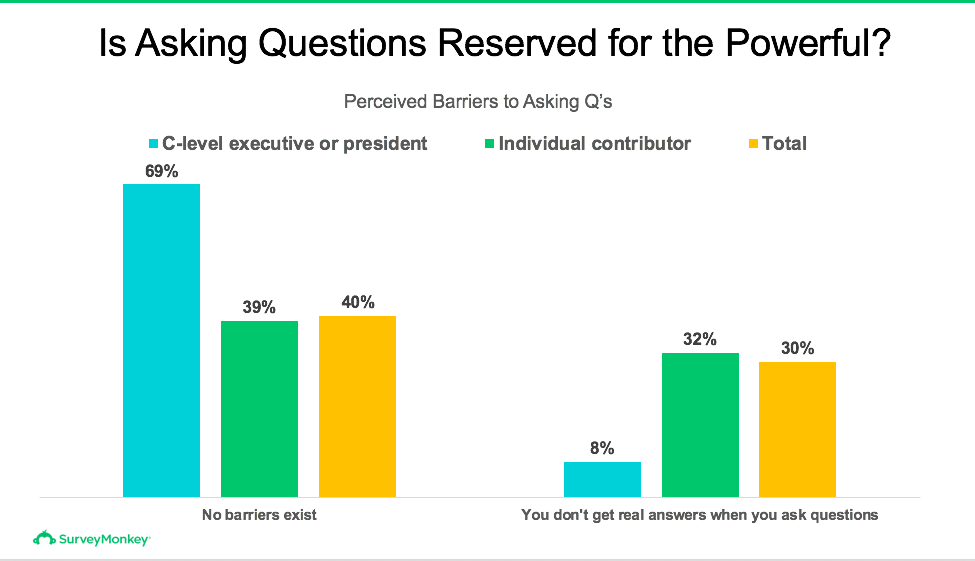—By Erin Pinkus and Jon Cohen
What differentiates us from machines? As humans, many people think “curiosity” is the superpower that will keep the workforce innovating far beyond what Johnny 5 could do. At least—that's what we hope: 57% of workers in a SurveyMonkey/FORTUNE survey believe human curiosity is keeping us ahead of artificial intelligence (AI).
But we wanted to dig deeper, so we partnered with THE creativity and curiosity researcher, Spencer Harrison to better understand the role of curiosity in the workplace. The data we found is striking, and now appears online in the Harvard Business Review and in the spotlight at TEDx. The full talk is here, but we’ve also summarized a few findings might pique your curiosity.
We surveyed more than 16,000 U.S. workers—including more than 1,500 top executives—to explore the role of curiosity in the American workplace, across industries and seniority levels. The results reveal how widely curiosity varies across across multiple dimensions, but most notably along with organizational hierarchies. In short, we find that curiosity is nurtured and seen as acceptable at the top, but is often stifled and allowed to languish at all other levels.
Here’s more of what we learned:
1. Most people are innately curious and eager to grow
Not only did we find evidence that almost all Americans (95%) see themselves as curious to some degree, but we also discovered the most curious workers are more often looking for new ways to grow. Fully 66% of those who self-identify as “extremely” or “very curious” find they are looking for development opportunities all the time or often.

2. Many institutions smother the spark of curiosity
Even though most people see themselves as curious, they still shy away from really leaning into that curiosity in the office. Why? Lack of transparency.
Among the study’s most striking findings: While the vast majority of top executives see “question-asking” as free and unencumbered in their workplaces, far fewer individual contributors feel they can ask with ease. The no. 1 reason? “You don’t get real answers when you ask questions”.

Nor do people feel incentivized: We found lots of individual contributors skeptical about the actual monetary value of being curious at work—only 16% believe that the more curious the employee, the more cash they make. There’s little perceived value in asking questions, or challenging the status quo. While more than half of top executives see their organizations as doing “a lot” to encourage curiosity, only 22% of those with lower ranking positions feel the same opportunity.

3. Curiosity is your superpower
In spite of these limits, curiosity has amazing potential. Our evidence suggests that fostering curiosity at work leads to employees engaging more deeply with their work, generating new ideas, and sharing those ideas with others.
Already, half (48%) of managers generate ideas as an expression of their curiosity, while 40% of non-managers use curiosity to share their ideas. The resounding takeaway is that people at all levels of power should feel “authorized” to ask questions—and ask them often. After all, curiosity is everyone’s superpower.
Feeling curious?
Check out our own Jon Cohen's TED Talk on curiosity in the workplace.
Methodology: This SurveyMonkey online survey “Curiosity in the Workplace”was conducted in three waves: June 21- 29, 2017 among a national sample of 13,331 adults ages 18 and up, including 8,988 people working full-time or part-time. September 1-11, 2017 among a national sample of 6,490 adults ages 18 and up, including 4,278 people working full-time or part-time, and October 21-26, 2017 among a national sample of 4,993 adults ages 18 and up, including 3,150 people working full-time or part time. Respondents for each wave were selected from over 2 million people who take surveys on the SurveyMonkey platform each day. Data have been weighted for age, race, sex, education, and geography using the Census Bureau’s American Community Survey to reflect the demographic composition of the United States. The modeled error estimate for each wave is plus or minus 1.5 for the first wave, and 2 percentage points for the latter two. More information on methodology: https://www.surveymonkey.com/mp/survey-methodology/




